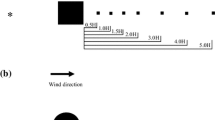Abstract
Introduction
Identifying geographic locations in urban areas from which air pollutants enter the atmosphere is one of the most important information needed to develop effective mitigation strategies for pollution control.
Materials and methods
Stochastic analysis is a powerful tool that can be used for estimating concentration fluctuation in plume dispersion in a wake region around buildings. Only few studies have been devoted to evaluate applications of stochastic analysis to pollutant dispersion in an urban area. This study was designed to investigate the concentration fields in the wake region using obstacle model such as an isolated building model. We measured concentration fluctuations at centerline of various downwind distances from the source, and different heights with the frequency of 1 KHz. Concentration fields were analyzed stochastically, using the probability density functions (pdf). Stochastic analysis was performed on the concentration fluctuation and the pdf of mean concentration, fluctuation intensity, and crosswind mean-plume dispersion.
Results
The pdf of the concentration fluctuation data have shown a significant non-Gaussian behavior. The lognormal distribution appeared to be the best fit to the shape of concentration measured in the boundary layer. We observed that the plume dispersion pdf near the source was shorter than the plume dispersion far from the source.
Conclusion
Our findings suggest that the use of stochastic technique in complex building environment can be a powerful tool to help understand the distribution and location of air pollutants.









Similar content being viewed by others
References
Cheung JCK, Melbourne WH (2000) Probability distribution of dispersion from model plume in turbulent wind. J wind eng ind aerodyn 87:271–285
Dennis F, Kirk C, Roger C, Jason R, Chris B, Martin L (2010) Analysis of urban atmosphere plume concentration fluctuations. Boundary-Layer Meteorol 2010, doi:10.1007/s10546-010-9510-3 (in press)
Diner N, Kaplan H, Kleiman M (1988) Characteristics of concentration fluctuations of a surface plume in neutral boundary layer. Boundary layer meteorol 45:157–175
Fung JCH, Perkins RJ (2008) Dispersion modeling by kinematic simulation: cloud dispersion model. Fluid Dyn Res 40:273–309
Gailis R, Hill A (2006) A wind-tunnel simulation of plume dispersion within a large array of obstacles. Boundary layer meteorol 119:289–338
Hanna SR, Insley EM (1989) Time series analysis of concentration and wind fluctuations. Boundary layer meteorol 47:31–147
Li QS, Calderone I, Melbourne WH (1999) Probabilistic characteristics of pressure fluctuations in separated and reattaching flows flow various free-stream turbulence. J Wind Eng Ind Aerodyn 82:125–145
Luhar AK, Hibberd MF, Borgas MS (2000) A skewed meandering plume model for concentration statistics in the convective boundary. Atmos Environ 34:3599–3616
Ma Y, Boybeyi Z, Hanna S, Chayantrakom K (2005) Plume dispersion from the MVP field experiment: analysis of surface concentration and its fluctuation. Atmos Environ 39:3029–3054
Mylne KR, Mason PJ (1991) Concentration fluctuation measurements in dispersion at a range of up to 1000 m. QJR Meteorol Sco 117:177–206
Nielsen M, Chatwin PC, Jørgensen HE, Mole N, Munro RJ, Ott S (2002) Concentration fluctuations in gas releases by industrial accidents. COFIN project, ENV4-CT97-0629
Peterson H, Lamb B (1995) An investigation of instantaneous diffusion and concentration fluctuations. J Appl Meteorol 34:2724–2746
Sawford BL (1987) Conditional concentration statistics for surface plumes in the atmospheric boundary layer. Bound Lay Met 38:209–223
Weil JC, Snyder WH, Lawson RE Jr, Shpman MS (2002) Experiments on buoyant plume dispersion in a laboratory convection tank. Boundary layer meteorol 102:367–414
Yassin MF, Ohba M, Tanaka H (2008) Experimental study on flow and gaseous diffusion behind an isolated building. Environ Monit Assess 147:149–158
Yee E, Biltoft CA (2004) Concentration fluctuation measurements in a plume dispersing through a regular array of obstacle. Boundary layer meteorol 111:363–415
Yee E, Chen RA (1997) Simple model for the probability density function of concentration fluctuations in atmospheric plume. Atmos Environ 31:99–1002
Yee E, Gailis RM, Hill A, Hilderman T, Kiel D (2006) Comparison of wind-tunnel and water-channel simulations of plume dispersion through a large array of obstacles with a scaled field experiment. Boundary layer meteorol 121:389–432
Yee E, Wang B, Lien F (2009) Probabilistic Model for concentration fluctuations in compact-source plumes in an urban environment. Boundary layer meteorol 130:169–208
Author information
Authors and Affiliations
Corresponding author
Additional information
Responsible editor: Zhihong Xu
Rights and permissions
About this article
Cite this article
Yassin, M.F., Elmi, A.A. Stochastic analysis of concentration field in a wake region. Environ Sci Pollut Res 18, 270–281 (2011). https://doi.org/10.1007/s11356-010-0372-5
Received:
Accepted:
Published:
Issue Date:
DOI: https://doi.org/10.1007/s11356-010-0372-5




